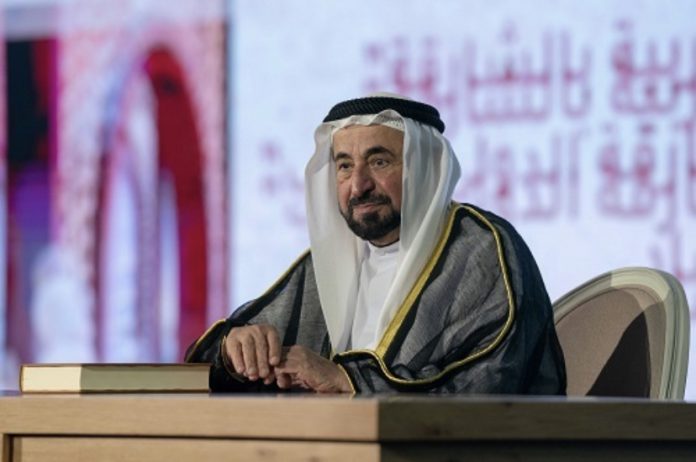A historical cultural feat for the Arab world has been attained, as His Highness Sheikh Dr. Sultan bin Muhammad Al Qasimi, Member of the Supreme Council and Ruler of Sharjah, released the first 17 volumes of the Historical Corpus of the Arabic Language – the first-of-its kind project to chronicle 17 centuries of development in the Arabic language, in the presence of His Highness Sheikh Sultan bin Ahmed Al Qasimi, Crown Prince and Deputy Ruler of Sharjah.
The Corpus volumes were unveiled by the Sharjah Ruler during the opening ceremony of the 40th edition of the Sharjah International Book Fair (SIBF) on Tuesday (2 November) atExpo Centre Sharjah, in the presence of a host of Arab ministers, presidents of Arabic language academies in the regionand several Arabic scholars and researchers. HH Ruler of Sharjah also unveiled the official website of The Historical Corpus of the Arabic Language on this occasion.
In his keynote address, the Sharjah Ruler noted: “Arabic is one of the oldest living languages. We are here to celebrate Arabic language experts who gathered to work for years to document the roots and meanings of the Arabic language alphabet. We have started to work hard and bridge the gaps that existed in the documentation of the language. Finally, the sun has risen on this beautiful Corpus, which is the fruit of the efforts of a number of Arabic language institutions across the region.”
He added: “The role this detailed corpus will play in informing and educating students, researchers, and linguists and even the everyday language enthusiasts will be immense. I am not exaggerating when I say that there has been no other project that has attracted my attention or the attention of the Arab linguist community in our region to the extent that this project has. I am following up on the development of the efforts of everyone involved in this project, and I assure you that in the coming years we will be publishing several more volumes. I thank each and everyone involved in making this project a success.”
The Sharjah Ruler spoke about the online platform and smart phone applications that have been designed to make the Historical Corpus available digitally, and facilitate easy access to these resources from anywhere in the world. He also signed the copies of the first edition of the Historical Corpus of the Arabic Language at the SIBF 2021 opening ceremony.
The first volumes of the corpus are dedicated to the first five Arabic letters: the hamza (ء), ba (ب), ta (ت) tha (ث) and jeem (ج) and outline their evolution throughout the pre-Islamic period, the Islamic era from 1 AH to 132 AH, the Abbasid Caliphate from 133 AH to 656 AH, and the modern-day era from 1214 AH to date.
Dedicated website
The website dedicated to the Historical Corpus of the Arabic Language will offer scholars, linguists, researchers and language enthusiasts access to the 17 volumes of the corpus from anywhere in the world.
Champions of the Arabic language from across the region joined hands
The corpus has seen the collaboration of hundreds of researchers and linguists, editors and experts from 10 Arabic language academies across the Arab world, under the supervision of the Union of Arab Scientific Language Academies in Cairo, Egypt, and with the Arabic Language Academy in Sharjah managing the project’s executive committee. The corpus relies on a database of sources collected and digitised over the last four years, comprising 20,000 Arabic books, manuscripts, sources, and historical documents, including old inscriptions and archaeological finds.
The Historical Corpus of the Arabic Language is dedicated to providing key information about the history of Arabic lexicon, the original root of each word and all other words that are derived from the root with their vocal and phonetic changes. It traces the history of a given word and identifies the first user and evolution of that word from pre-Islamic Arabia all the way to the modern time. In this respect, it is different from any other dictionary because it cites living verses of the Holy Quran and Hadith of the Prophet, peace be upon him.
It also reveals the development of Arabic idioms and expressions through the centuries, and documents the entry of new words into Arabic language, lists words that are no longer used, and explains the reasons why. Besides, the corpus reviews the development of arts and sciences that directly relate to linguistics including grammar, morphology, philology, phonetics, rhetoric, rhyme, and so on.
It also offers comparative lexical reviews on Arabic and the influence it had on other Semitic languages such as Hebrew, Akkadian, Syriac, Abyssinian, and Amharic. An expert committee outlined the similarities and differences between Arabic words and the equivalent words in those languages, citing examples and documenting the bibliography and reference books that were used in the project.
Several senior officials were present during the launch, including Sheikh Nahyan bin Mubarak Al Nahyan, UAE Minister of Tolerance and Coexistence; Bodour Al Qasimi, President of the International Publishers Association; Sheikha Hoor Al Qasimi, President of the Sharjah Art Foundation; Sheikh Khalid bin Issam Al Qasimi, Chairman of the Department of Civil Aviation in Sharjah; Sheikh Salem bin Abdulrahman Al Qasimi, Chairman of the Sharjah Ruler’s Office; Sheikha Nawar bint Ahmed Al Qasimi, Director, SAF; Abdul Rahman bin Mohammad Al Owais, UAE Minister of Health and Prevention.
The launch of the corpus’s 17 volumes was also witnessed by Dr. Salah Fadl, President of the Arab Language Academy in Cairo; Dr. Mamoun Wajeeh, Scientific Manager of the Historical Corpus of the Arabic Language; Dr. Abdulhamid Madkour, Secretary General of the Union of Arab Scientific Language Academies, and Secretary-General of the Arabic Language Academy in Cairo.
Source: AETOSWire










